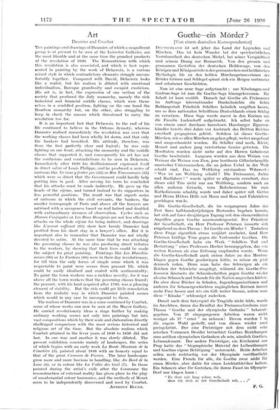Art
Daumier and Courbet
THE paintings and drawings of Daumier, of which a magnificent group is at present to be seen at the Leicester Galleries, are the most likeable and at the same time the grandest products of the revolution of 1830. The Romanticism with which this revolution is also associated, and which is best repre- sented in painting by the work of Delacroix, is a curious mixed style in which contradictory elements struggle uncom- fortably together. Compared with David, Delacroix looks like a realist, but his realism is diluted with emotional individualism, Baroque grandiosity and escapist exoticism. His art is, in fact, the expression of one section of the society that produced the July monarchy, namely the rich industrial and financial middle classes, which were them- selves in a muddled position, fighting on the one hand the Bourbon monarchy but, on the other, also struggling to keep in check the masses which threatened to carry the revolution too far.
It is an important fact that Delacroix to the end of his life continued to believe in the Orleans dynasty, whereas Daumier realised immediately the revolution was over that the working classes had been wholly let down, and that only the bankers had benefited. His attitude, therefore, was from the first perfectly clear and logical ; he was only fighting on one front, attacking the monarchy and the middle classes that supported it, and consequently his art has not the confusions and contradictions to be seen in Delacroix. Immediately after 1830 his disillusionment expressed itself in direct satire of Louis Philippe, and he produced a series of cartoons like Ne vous y froller pas (23) or Rue Transnonain (35) which were so direct that the Government could hardly help putting him in gaol. After serving his term he concluded that his attacks must be made indirectly. He gave up the heads of the regime, and turned instead to its supporters in less powerful positions. The result was that superb series of cartoons in which the civil servants, the bankers, the smaller townspeople of Paris and above all the lawyers are satirised with a savageness based on real hatred and doubled with extraordinary niceness of observation. Cycles such as Mocurs Conjugales or Les Bons Bourgeois are not less effective attacks on the whole regime for being indirect, and drawings like L'avocal suffisanl (81) show how keenly Daumier had profited from his short stay in a lawyer's office. But it is important also to remember that Daumier was not wholly devoted to satire. At the same time that he was attacking the governing classes he was also producing direct tributes to the workers, by showing that their lives could be made the subject for great painting. Paintings like Les Blanchis- senses (90) or Le Fardeau (88) were in their day revolutionary, for till then the only forms of simple scene which it was respectable to paint were scenes from peasant life, which could be easily idealised and coated with sentimentality.
To paint the town workers was a reckless novelty, for it was above all the town workers that the governing classes feared ; the peasant, with his land acquired after 1789, was a pleasing element of stability. But the rich could get little consolation from the realistic way in which Daumier painted scenes which would in any case be uncongenial to them.
The realism of Daumier was in a sense continued by Courbet, some of whose works can now be seen at the Mayor Gallery. He carried revolutionary ideas a stage further by making ordinary working scenes not only into paintings but into vast compositions which by their scale and elaboration directly challenged comparison with the most serious historical and religious art of the time. But the absolute realism which Courbet attained in the fever years of 1848 to 1850 did not last. In one way and another it was slowly diluted. The present exhibition consists mainly of landscapes, the series of which begins with an early work La Route Monlanle de la Cimeliire (3), painted about 1848 with an honesty equal to that of the great Casseurs de Pierres. , The later landscapes grow more and more luscious in handling, like Au Bord de la Loue (6), or in colour like La Vallee des Guil (7). In those painted during the artist's exile after the Commune the reconstruction of external reality has given place to the play of unsubstantial colour harmonies, and the methods of Monet seem to be independently discovered and used by Courbet.
ANTHONY BLUNT.










































 Previous page
Previous page